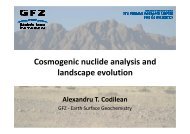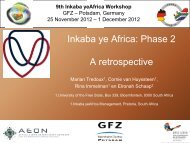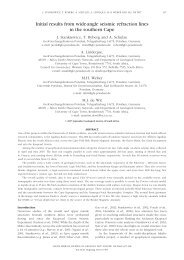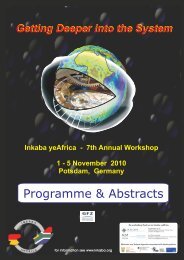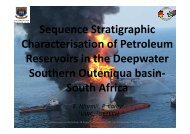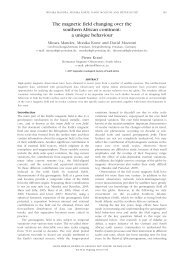South Africa - Inkaba.org
South Africa - Inkaba.org
South Africa - Inkaba.org
You also want an ePaper? Increase the reach of your titles
YUMPU automatically turns print PDFs into web optimized ePapers that Google loves.
Cosmogenic nuclide-based perspectives on long-term<br />
landscape evolution models and short-term soil erosion rates<br />
in southern <strong>Africa</strong><br />
J.E. Decker 1* , S. Niedermann 2 , M.J. de Wit 3<br />
1. AEON and Department of Geological Sciences, University of Cape Town, Rondebosch 7700, <strong>South</strong> <strong>Africa</strong>,<br />
geojedenator@gmail.com<br />
2. Deutsches GeoForschungsZentrum, 14473 Potsdam, Germany, nied@gfz-potsdam.de<br />
3. AEON and Department of Geological Sciences, University of Cape Town, Rondebosch 7700, <strong>South</strong> <strong>Africa</strong>,<br />
Maarten.DeWit@uct.ac.za<br />
*Present address: Petroleum Agency SA, 7 Mispel Road, Tygerpoort Building, Bellville 7789, <strong>South</strong> <strong>Africa</strong>,<br />
deckerj@petroleumagencysa.com<br />
ABSTRACT<br />
<strong>South</strong>ern <strong>Africa</strong>’s landscape is characterised by a high plateau (elevation > 1,000 m) bound by escarpments and<br />
extensional continental margins, and the region has been influential in the development of geomorphological<br />
theory. The abundances of cosmogenic noble gas nuclides ( 3 He, 21 Ne and 38 Ar) in pyroxene separates from 22<br />
Early Jurassic (~183 Ma) Karoo dolerite surface samples from southern <strong>Africa</strong> indicate minimum exposure ages<br />
that range from ~20 ka to ~500-700 ka. Corresponding maximum erosion rates range from ~0.6 m/Myr to ~20<br />
m/Myr, with most values < ~4 m/Myr. This data implies a decline in denudation rates over time, as these recent<br />
surface process rates are too low to account for the form of topographic features. Low maximum erosion rates are<br />
interpreted as weathering rates, but do not correlate with lithological and present-day climatic variables. However,<br />
dolerite weathering rates are similar to theoretical basalt weathering fluxes modelled as a function of present-day<br />
temperature and run-off. Regional discrepancies between measured and model values may be interpreted as an<br />
indication of a variable late Quaternary palaeoclimate. Dolerite weathering rates are also similar to stratigraphically<br />
determined Holocene denudation rates, suggesting that denudation has been weathering-limited over this time<br />
period. Finally, if Karoo dolerite maximum erosion rates are interpreted as soil production rates, it is estimated that<br />
modern rates of soil erosion in southern <strong>Africa</strong> are up to two orders of magnitude higher than rates of soil<br />
production, implying that modern land-use practices are unsustainable.<br />
Key words: cosmogenic nuclides, Karoo dolerite, landscape evolution, soil erosion, noble gases<br />
22



